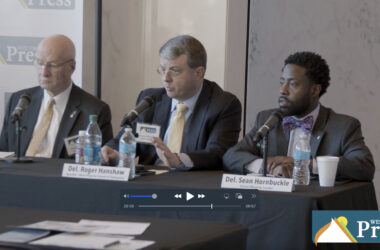By ANDREA LANNOM
The Register-Herald
CHARLESTON, W.Va. — Economists in Gov. Jim Justice’s office are forecasting that West Virginia’s budgetary indicators are the worst since the Great Depression, Justice’s chief of staff said Wednesday.
Nick Case said for the 2018 fiscal year, West Virginia will have to reduce its budget by $497 million.
“We have economists that work internally for us who do economic forecasting and revenue forecasting. The forecast we have right now, they say West Virginia’s indicators are the worst since the Great Depression,” Casey said. “I don’t want to sound doom and gloom but this is a moment in time that when Gov. Gaston Caperton came in here and everything was upside down and he came in and did a lot of things — it’s worse than that.
“Every revenue item is down,” Casey said. “Severance, corporate net income tax, even beer tax is down. Beer tax never goes down. Because revenue is on decline, that puts pressure on the budget and constitutionally, we have to have a balanced budget.”
Previous Department of Revenue Secretary Robert Kiss had reporter in November that if the budget stayed where it had been the last couple of years, the revenue shortfall for the 2018 fiscal year could be in the neighborhood of $400 million.
“What Gov. Justice is facing is an enormous, enormous budget challenge,” Casey said. “This is not a casual situation we have here. Some of the people in the budget office are telling us this is the worst budget we’ve ever had. We are attentive to that.”
The state does a six-year plan, a forecast. The six-year plan is a $497 million deficit and revenue is not sufficient to meet that amount, he said.
“It’s a true budget crisis,” Casey said. “We are working diligently on that to reduce the budget. It’s been reduced by 10 percent of the state budget. We will have to reduce it another 10 percent and it is going to change the way we deliver services by the state. There are things we may not be doing — things we may have to reduce. It’s dramatic.”
Casey commended Gov. Earl Ray Tomblin, saying he did a good job controlling costs, including across-the-board cuts.
In November, Tomblin announced a 2 percent-across-the-board mid-year cut to West Virginia’s agencies, issued an executive order redirecting $25.5 million to pay the unfunded liability of the Workers’ Compensation debt reduction fund to the general revenue fund and a one-time cut to Medicaid of $25 million.
“I don’t think these kinds of cuts are working at this stage,” Casey said. “It’s made everything thin. There are things that we do that we have to eliminate because we can’t afford it. It will cause discomfort. Things are going to affect people and programs. I don’t like that but we are analyzing closely who is impacted and how badly. It’s going to be very painful circumstances by changing the budget.”
As far as cuts, Casey said for right now, “everything is on the table.”
“Name something and we’re looking at how to deal with it,” he said. “There may be areas that we put in more money. Gov. Tomblin was specific that if we put more jobs, there will be more activity. If we enhance tourism, people will be coming into the state and spending money. It’s not just cuts. Some folks may see additional funding because they can do more with it.”
In his farewell address, Tomblin presented a proposed budget for the 2018 fiscal year, including a 1 percent increase to consumer sales tax, which he said would raise $200 million. He also proposed getting rid of the sales tax exemption on telecommunications services.
“These are the very things talked about in the last legislative session and in the last legislature, on the House side, there was no appetite for those two taxes,” Casey said. “I appreciate Tomblin’s efforts to revisit that, but we hear what they say. They looked at those and didn’t like them. I don’t have expectations that they are inclined to do consumer sales tax or change or increase the telecommunications tax. That’s why we are looking at cuts and reductions because we heard them and they struggled with it and we respect them.”
When asked if any positions in state government would be cut, Casey said, “There is no question one of the major costs of state government is people.
“We don’t want anyone to lose their position, but there is no way a cut in the budget can be made without impacting people who work for the state. It’s awful. We hate it,” he said. “In the last session, the Legislature had a funding adjustment, cutting forestry. We lost 17 foresters. It was awful but that was in a budget year that is nowhere near as difficult as the upcoming budget year.”
In his inaugural address, Justice said he wanted to eliminate “a bunch of unnecessary agencies.” Casey said Justice has made it clear that the level of regulation for education in the classroom level is significant and is looking at modifying or streamlining those.
“Restructuring is one thing we would like to do — restructuring supervisory agencies,” he said.
Casey mentioned the Regional Education Support Agencies, Office of Education Performance Audits, Center for Professional Development and the School Board Associations, saying they would be “much better with restructuring.”
“You look at all the different bodies of administrators overhead and they work for the collective good for education,” Casey said. “Can’t we restructure this in some manner to reduce overhead and reduce the quantity of regulations? Instead of having four sets, can we get it down to one set? I don’t think it would have a negative impact on education. It would be less burden on teachers and administrators.”
In a previous hearing before the Joint Committee on Government Operations, a legislative auditor recommended eliminating or restructuring eight RESAs. The auditor had recommended instead of coming through regional agencies, to go through regional staff at the Department of Education, saying duplication would be removed and the state would save money.
State Board of Education Superintendent Michael Martirano said during last week’s meeting of the state board that the department is “by no means staffed in an appropriate way to begin that process.”
Earlier on Wednesday, Justice’s office announced that it would eliminate five state cars previously used by office representatives, citing budgetary reasons.
“We won’t be able to climb out of this ditch until we really dive into the books to find cuts and cost-saving measures,” Justice said in the news release. “State government owes it to every taxpayer to be as fiscally responsible as possible.
“My administration will work every angle to cut waste; this is only the beginning. We determined that the cars are not necessary for my staff. I am asking my entire cabinet to explore ways to trim waste, no matter how small.”
Casey said it became immediately apparent that they could reduce the number of cars because they weren’t an essential part of the job.
As an example, he said one of the employees covers 16 counties but didn’t use the car except on rare occasions.
Casey said the office is down to two state cars. One is available for anyone from the governor’s office to use and the other is the governor’s car, he said.
“It’s not a giant cost to state government but it is a cost,” Casey said.
He said the cost savings is hard to determine, mentioning insurance fees, administrative fees, licensing and inspection. He said the state vehicles are insured through BRIM, the state’s insurance.
“In the big picture of life, we’re hoping that jettisoning five cars will save about $1,000 a month for the next four years,” Casey said. “Is it enough to make the budget balance? No. But every bit helps.”
The office will surrender the cars to the state’s motor pool. Then, Casey said, if the state needs to buy more cars, they can have the use of these five cars and can dispose of excess vehicles. He said he expects a reduction in that level as well.
“These cars are in good shape so they could get rid of some of the other ones that are in lesser shape,” he said. “The idea is there are way too many cars. We need to match up the vehicles to the job. If a job requires a vehicle like the State Police, they need the best car available to do their job. The governor’s office didn’t have the job activity to match up to the amount of cars.”
See more from The Register-Herald





